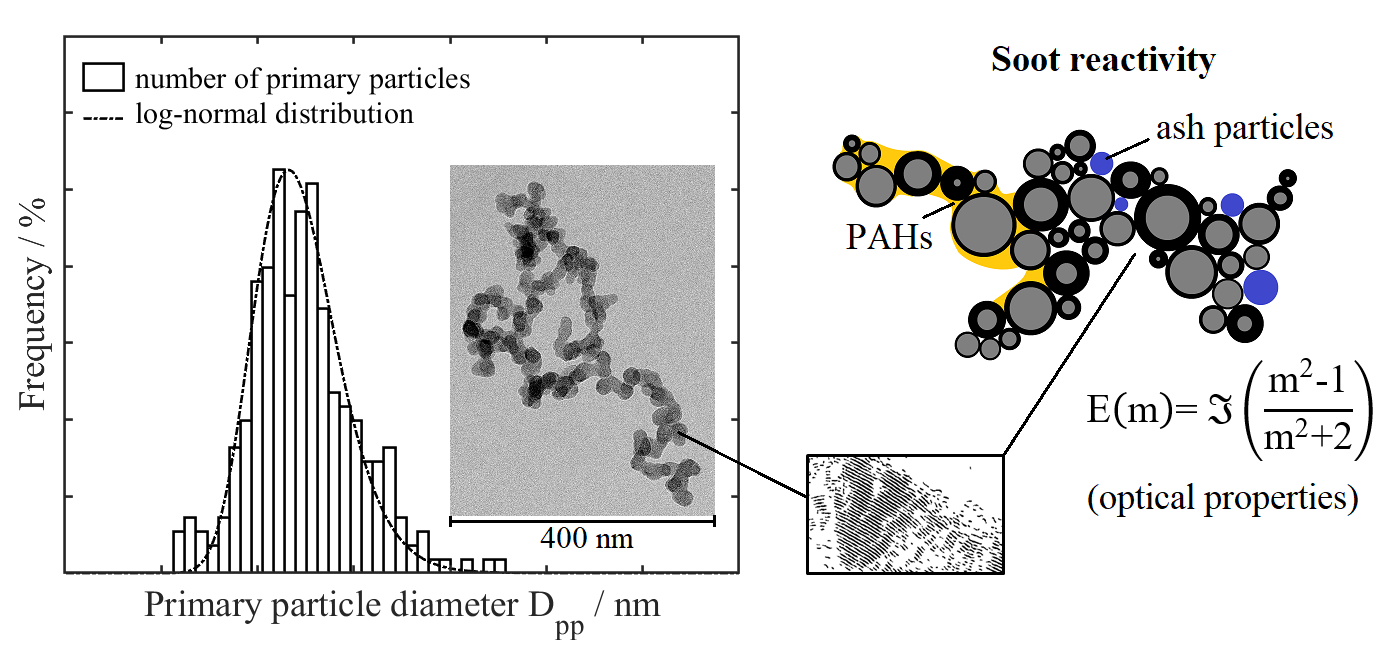Reactivity of particles from spark ignition engines: correlations between the particle structure, its optical properties and engine operating parameters
In the course of European exhaust gas legislation, particulate emissions from gasoline engines with direct injection (DE) are a new core topic of engine development. Studies have shown that the mass-related emission limit value can generally be complied with using current engine technology. In contrast, compliance with the maximum permissible particle number concentration represents a major challenge. The reason for the strongly increased nanoscale particle emissions compared to the classic four-stroke gasoline engine with intake manifold injection is the incomplete homogenization of fuel. The result is locally sub-stoichiometric combustion zones which, due to incomplete combustion, favour particle formation. Nevertheless, the technology of gasoline direct injection is to be welcomed in principle, especially for reasons of efficiency and climate protection. However, it is important to reduce particulate emissions in such a way that they remain well below the European exhaust emission limit value and thus protect human health at the same time.
In order to comply with the limit values, the soot particles must therefore be converted with oxidative reactants. This takes place both in the engine cylinder and in the exhaust tract, and finally on the particulate filter. In each of these partial steps, which take place on different time scales and temperature levels, the soot particles undergo an oxidation reaction. The reactivity of soot particles that form at a specific operating point of the DE gasoline engine can be attributed to both their microstructural and nanostructural characteristics. From a large number of measurable particle characteristics, it is necessary to identify those that have a dominant influence on the reactivity behaviour. Subsequently, it is possible to derive particle property-reactivity relationships on the basis of which the reactivity of the particles can be controlled via engine operation.
Within this DFG funded research project, soot samples are taken from a DE research gasoline engine at different operating conditions to determine particle property-reactivity relationships. These will be analysed ex-situ with regard to their reactivity, structure and other properties.
A further aim is to reproduce the properties essential for the reactivity of the soot particles in synthetic model soot particles in order to minimise the effort of generating particles through lengthy and cost-intensive experiments on the engine test bench. In this context, various strategies are being pursued.
The third aim of the project is to detect the reactivity-relevant micro- and nanostructural particle properties in-situ using laser-optical measurement technology. The fast, non-contact, optical detection of reactivity-relevant particle properties offers the possibility to measure the reactivity of particles in small time scales without taking samples. The reactivity of particles is presumably determined by (a) their geometrical, microstructural properties and (b) the nanostructural structure, i.e. the order, orientation and extension of existing graphene layers. For the detection of these particle features, different laser-optical methods are combined. The validation of the measurement technique is carried out using model soot aerosols.
To achieve the goals, an interdisciplinary approach is necessary, which is ensured by three institutes - Institute for Piston Machinery (IFKM), Engler-Bunte Institute / Combustion Technology Division (EBI-VBT), Institute for Technical Chemistry and Polymer Chemistry (ITCP).

Publications
Seitz, M.; Kannengießer, M. P.; Stelzner, B.; Hagen, F. P.; Braun, L.; Kaltenbach, J.; Märkle, K.; Peterlechner, M.; Spielmann, J.; Doronkin, D. E.; Deutschmann, M. P.; Grunwaldt, J.-D.; Eggeler, Y. M.; Kramm, U. I.; Nirschl, H.; Trimis, D.
2026. Fuel, 405, Art.-Nr.: 136422. doi:10.1016/j.fuel.2025.136422
Ahrendt, F.; Schmitz, R.; Hagen, F. P.; Vlavakis, P.; Trimis, D.; Ferraro, F.
2026. Applications in Energy and Combustion Science, 25, Article no: 100435. doi:10.1016/j.jaecs.2025.100435
Hazenberg, T.; Braig, D.; Fedoryk, M. A.; Mich, J.; Hagen, F. P.; Harth, S. R.; Stelzner, B.; Scholtissek, A.; Trimis, D.; Hasse, C.
2026. Fuel, 403, 136094. doi:10.1016/j.fuel.2025.136094
Vlavakis, P.; Hagen, F. P.; Loukou, A.; Trimis, D.
2025. Combustion and Flame, 282, 114513. doi:10.1016/j.combustflame.2025.114513
Hagen, F. P.; Müller, J. H.; Störmer, H.; Stelzner, B.; Eggeler, Y. M.; Trimis, D.
2025. Fuel, 398, Art.:135598. doi:10.1016/j.fuel.2025.135598
Knapp, S.; Hagen, F. P.; Wagner, U.; Bockhorn, H.; Trimis, D.; Koch, T.
2025. SAE Technical Papers, 2025–24, SAE International. doi:10.4271/2025-24-0081
Kretzler, D.; Puri, R.; Stelzner, B.; Zirwes, T.; Hagen, F. P.; Stein, O. T.; Trimis, D.
2025. Proceedings of the Combustion Institute, 41, 105854. doi:10.1016/j.proci.2025.105854
Saggese, C.; Whitesides, R.; Wagnon, S. W.; Chatterjee, T.; Hagen, F. P.; Vlavakis, P.; Schraud, N.; Trimis, D.
2025. Proceedings of the Combustion Institute, 41, Art.-Nr.: 105816. doi:10.1016/j.proci.2025.105816
Mangipudi, M.; Denev, J. A.; Bockhorn, H.; Trimis, D.; Koch, T.; Debus, C.; Götz, M.; Zirwes, T.; Hagen, F. P.; Tofighian, H.; Wagner, U.; Braun, S.; Lanzer, T.; Knapp, S. M.
2025. SAE Technical Paper Series, 2025–01, SAE International. doi:10.4271/2025-01-0321
Desens, O.; Hagen, F. P.; Meyer, J.; Dittler, A.
2025. 2025 Stuttgart International Symposium on Automotive and Engine Technology, 2025–01, SAE International. doi:10.4271/2025-01-0312
Kalbhor, A.; Schmitz, R.; Ramirez, A.; Vlavakis, P.; Hagen, F. P.; Ferraro, F.; Braun-Unkhoff, M.; Kathrotia, T.; Riedel, U.; Trimis, D.; van Oijen, J.; Hasse, C.; Mira, D.
2024. Combustion and Flame, 260, Art.-Nr.: 113220. doi:10.1016/j.combustflame.2023.113220
Hagen, F. P.
2024, January 9. Karlsruher Institut für Technologie (KIT). doi:10.5445/IR/1000166087
Hagen, F. P.; Vlavakis, P.; Bockhorn, H.; Suntz, R.; Trimis, D.
2023. Combustion and Flame, 258, 112729. doi:10.1016/j.combustflame.2023.112729
Fortugno, P.; López-Cámara, C.-F.; Hagen, F.; Wiggers, H.; Schulz, C.
2023. Applications in Energy and Combustion Science, 15, Atkl.Nr.: 100180. doi:10.1016/j.jaecs.2023.100180
Hagen, F. P.; Kretzler, D.; Koch, S.; Bockhorn, H.; Suntz, R.; Trimis, D.; Kubach, H.; Velji, A.; Koch, T.
2023. Combustion and Flame, 254, Art.-Nr.: 112850. doi:10.1016/j.combustflame.2023.112850
Bauer, M.; Hagen, F.; Kretzler, D.; Schulz, S.; Stelzner, B.; Bockhorn, H.; Suntz, R.; Trimis, D.
2023. 31. Deutscher Flammentag (2023), Berlin, Germany, September 27–28, 2023
Hagen, F. P.; Vlavakis, P.; Seitz, M.; Klövekorn, T.; Bockhorn, H.; Suntz, R.; Trimis, D.
2023. Proceedings of the Combustion Institute, 39 (1), 1119–1128. doi:10.1016/j.proci.2022.07.253
Koch, S.; Hagen, F. P.; Büttner, L.; Hartmann, J.; Velji, A.; Kubach, H.; Koch, T.; Bockhorn, H.; Trimis, D.; Suntz, R.
2022. Emission Control Science and Technology, 8 (1-2), 9–35. doi:10.1007/s40825-022-00211-y
Hagen, F. P.; Suntz, R.; Bockhorn, H.; Trimis, D.
2022. Combustion and flame, 243, Art.Nr. 112020. doi:10.1016/j.combustflame.2022.112020
Hagen, F. P.; Kretzler, D.; Häber, T.; Bockhorn, H.; Suntz, R.; Trimis, D.
2021. Carbon, 182, 634–654. doi:10.1016/j.carbon.2021.06.006
Appel, D.; Hagen, F. P.; Wagner, U.; Koch, T.; Bockhorn, H.; Trimis, D.
2021. Journal of energy resources technology, 143 (8), Art.-Nr.: 082306. doi:10.1115/1.4050492
Hagen, F.; Hardock, F.; Koch, S.; Sebbar, N.; Bockhorn, H.; Loukou, A.; Kubach, H.; Suntz, R.; Trimis, D.; Koch, T.
2021. Flow, turbulence and combustion, 106 (2), 295–329. doi:10.1007/s10494-020-00205-2
Hagen, F. P.; Bockhorn, H.; Störmer, H.; Loukou, A.; Suntz, R.; Trimis, D.
2021. Proceedings of the Combustion Institute, 38 (1), 1153–1161. doi:10.1016/j.proci.2020.06.338
Appel, D.; Hagen, F. P.; Wagner, U.; Koch, T.; Bockhorn, H.; Trimis, D.
2020. ASME 2020 Internal Combustion Engine Division Fall Technical Conference, November 4–6, 2020, The American Society of Mechanical Engineers (ASME). doi:10.1115/ICEF2020-2932
Hagen, F. P.; Rinkenburger, A.; Günther, J.; Bockhorn, H.; Niessner, R.; Suntz, R.; Loukou, A.; Trimis, D.; Haisch, C.
2020. Journal of aerosol science, 143, Art.-Nr.: 105530. doi:10.1016/j.jaerosci.2020.105530
Koch, S.; Kubach, H.; Velji, A.; Koch, T.; Hagen, F. P.; Bockhorn, H.; Loukou, A.; Trimis, D.; Suntz, R.
2020. WCX SAE World Congress Experience, Detroit, April 21-23, 2020. doi:10.4271/2020-01-0392
Koch, S.; Hagen, F. P.; Kubach, H.; Velji, A.; Koch, T.; Bockhorn, H.; Loukou, A.; Trimis, D.
2019, June 18. 23rd ETH Conference on Combustion Generated Nanoparticles (2019), Zurich, Switzerland, June 17–20, 2019
Hagen, F.; Hardock, F.; Bockhorn, H.; Loukou, A.; Suntz, R.; Trimis, D.
2019. Proceedings of the European Combustion Meeting – 2019, April 14-17, Lisboa, Portugal, p. S1_R1_90
Hagen, F.; Hardock, F.; Bockhorn, H.; Loukou, A.; Suntz, R.; Trimis, D.
2019. Jahrestreffen der ProcessNet-Fachgruppen "Partikelmesstechnik und Aerosoltechnologie" (2019), Frankfurt am Main, Germany, March 6–7, 2019
Hagen, F.; Hardock, F.; Bockhorn, H.; Loukou, A.; Suntz, R.; Trimis, D.
2019. 11th Mediterranean Combustion Symposium, Tenerife, Spain, 16-20 June 2019
Hagen, F.; Hardock, F.; Bockhorn, H.; Loukou, A.; Suntz, R.; Trimis, D.
2019. 9th European Combustion Meeting 2019, 14 - 17 April, 2019, Lisboa, Portugal - Book of Abstracts. Ed.: S. Pereira, 126, Instituto Superior Técnico
Hagen, F.; Loukou, A.; Vlavakis, P.; Häber, T.; Bockhorn, H.; Suntz, R.; Trimis, D.
2018, August. 37th International Symposium on Combustion (2018), Dublin, Ireland, July 29–August 3, 2018
Hagen, F. P.; Saliba, G.; Saleh, R.; Zhao, Y.; Presto, A. A.; Lambe, A. T.; Frodin, B.; Sardar, S.; Maldonado, H.; Maddox, C.; May, A. A.; Drozd, G. T.; Goldstein, A. H.; Russell, L. M.; Robinson, A. L.
2017. Environmental Science & Technology, 51 (11), 6542–6552. doi:10.1021/acs.est.6b06509

